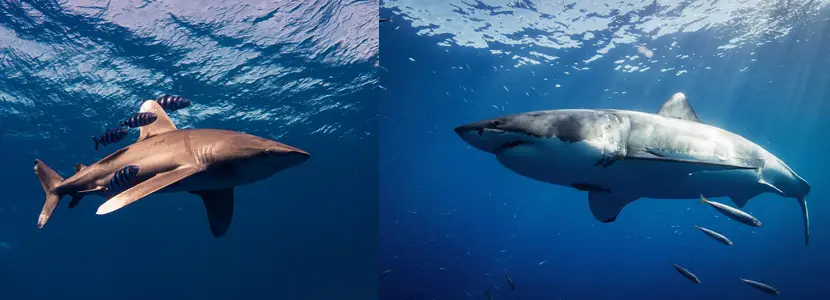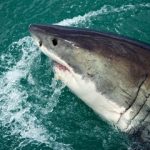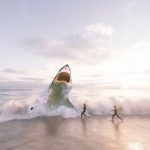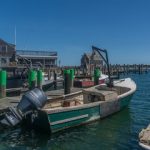
Two formidable sharks are the oceanic whitetip shark vs great white shark or Carcharhinus longimanus vs Carcharodon carcharias.
Oceanic whitetip shark vs great white shark are two shark species that mostly do not come face-to-face in the oceans, as they each prefer different sea temperatures. Great white sharks are on average 3.5 times larger by weight than oceanic whitetip sharks, but they are both formidable carnivores.
The best way to do more diving is to book yourself on a scuba diving liveaboard. You can check the latest and best deals on liveaboards using the following window:
The best way to understand the differences and similarities between oceanic whitetip sharks vs great white sharks is to see these in a table. Included in the table are the best places to find these sharks, and where’s the best place to scuba dive with them too.
If you are viewing this in a mobile phone, try turning it to landscape as this will help to view more columns.
Oceanic whitetip shark vs great white shark table of differences
| Difference | Oceanic Whitetip Shark | Great White Shark |
|---|---|---|
| Scientific name | Carcharhinus longimanus | Carcharodon carcharias |
| Translation | Carcharhinus means shark. Longimanus translates to "requiem". This means an oceanic whitetip shark is a requiem shark. | Carcharodon literally means "jagged tooth". carcharias is an Ancient Greek word for shark. This means a great white shark is a jagged tooth shark. |
| Type of animal | Fish | Fish |
| Other names | Brown Milbert's sand bar shark. Brown shark. Lesser white shark. Nigano shark. Oceanic white-tipped whaler. Sea dogs. Surface-dwelling shark. Common ship-following sharks. Carcharhinus maou. Squalus longimanus. Pterolamiops longimanus. | White shark. White pointer. Great white. White death. |
| Habitat and distribution | Tropical and sub tropical in warm temperate seas 20-28°C (68–82°F). Deep, open oceans, like the Pacific Ocean, the Atlantic Ocean, Indian Ocean and the Red Sea, Gulf of Guinea and Gulf of Mexico. Mostly found in the upper layer of the ocean at a depth of 150m (490ft). Mostly offshore in open oceans. | Generally prefer coastal and offshore waters with temperatures between 12-24°C (54-75°F). Coastal surface waters of all the major oceans. Can go to depths of 1,200m (3,900 ft). - Where Do You Find Great White Sharks (A Few Big Surprises!). |
| Length | Max: 4m (13 ft). Generally male and females 3m (9.8 ft). | Generally females 4.6-4.9m (15-16 ft). Generally males 3.4-4.0 m (11-13 ft). Max: 6.1m (20ft) (female). |
| Weight | Max: 170kg (370lb). Average weight: 86kg (190lb). | Max: 1,905–2,268kg (4,200–5,000lb). Average weight: 522–771kg (1,151–1,700lb). |
| Swim speed | Average speed: 2.2-2.6kmh (1.4-1.6mph). Top speed: 16kph (10.2mph) | Average speed: 2.4-8kmh (1.5-5mph) Top speed: 56kmh (35mph) |
| Colour | Dorsally (upper body): Grey-bronze. Ventrally (underbelly): White. Fins - Mottling with white tips. | Dorsally (upper body): Slate-grey Ventrally (underbelly): White. |
| Characteristics and distinguishing feature | Long, rounded wing-like pectoral and dorsal fins, which are significantly larger than most other shark species. The fins look like paddles. | Pointed conical snout, large bulky torpedo like body and distinctive white underbelly. They have large pectoral and dorsal fins, plus a strong crescent-shaped tail. Best described as a blunt torpedo. |
| Diet | Oceanic whitetips sharks are carnivores and hunt across vast areas of empty ocean scanning for possible food sources. Eat: Pelagic cephalopods like squid, lancetfish, oarfish, barracuda, jacks, dolphinfish, marlin, tuna, mackerel, birds and mammalian carrion. Hunt mostly at night. | Great white sharks are carnivores Eat: Fur seals, sea lions, cetaceans, which are aquatic mammals, other sharks, and large bony fish species. Mostly hunt early morning within 2 hours of sunrise. |
| Behaviour | Typically solidary, but can be founds in pairs or more, especially when food is abundant. Never sleep. Opportunistic, aggressive, bold and inquisitive. | Typically solidary, but can be founds in pairs or more, especially when food is abundant. Very curious intelligent creatures and can be highly aggressive. |
| Dangerous to humans and will it eat humans | Dangerous to shipwreck survivors. Understood to have killed and eaten more humans than any other shark during World War II, but this is unrecorded. Jacques Cousteau described the oceanic whitetip as "the most dangerous of all sharks". - Brothers Shark Attack: Oceanic Whitetip Shark Attacks Diver. - Elphinstone Reef Shark Attack: Close Up Oceanic Whitetip Shark. | More human bite incidents than any other shark. Humans are not the preferred prey of the great white shark. |
| Captivity | Monterey Bay Aquarium's had an oceanic whitetip shark that lived for over 3 years before dying in 2003. | Cannot be kept in captivity. - Why Do Great White Sharks Die In Captivity. |
| Conservation status | Due to fishing for shark fins, oceanic whitetip shark numbers have fallen by 70% from 1992 and 2000. Critically Endangered. | Vulnerable species Protected in many countries. |
| How to behave as divers around the shark | - Be aware oceanic whitetip sharks will probe persistently and wait for the perfect opportunity to sneak an attack. - Also be aware that oceanic whitetip sharks are bold and unpredictable and can be aggressive towards divers. | Safest way to scuba dive with great white sharks is in a cage. |
| Best place to scuba dive | Red Sea Elphinstone reef. Red Sea The Brothers. Red Sea Daedalus Reef. Hawaii. - Elphinstone Reef Dive Site: How To Get To The Best Diving Egypt. - The Brothers Red Sea: Brothers Islands Scuba Diving. - https://www.scubadivingearth.com/red-sea-daedalus-reef-dive-site/. | South Africa’s Dyer Island and False Bay. Neptune Island, south coast of Australia. North west coast of America and California. East coast of America. Stewart Island, New Zealand. - Where Is The Best Place To Cage Dive With Sharks? (6 Best Shark Cage Diving). - Shark Cage Diving San Diego, California (San Diego Great White Shark). - Cage Dive Great White Sharks Australia Liveaboard (Seabed Cage Diving). |
| Lifespan | 36 years | 70 years |
| How they breath | Ram breathing, which means they have to swim constantly to pump oxygen over their gills. | Ram breathing, which means they have to swim constantly to pump oxygen over their gills. |
| Famous for | Skin is used for leather and desirable for their fins for shark fin soup. | JAWS the movie by Steven Spielberg. |
| Reproduction | Give birth to: 1-14 pups that are 60cm (2ft) in length. Gestation: 10-12 months. Sexual maturity: 7 years. | Give birth to: 1-14 pups that are 1.5m (5ft). Gestation: 11 months. Sexual maturity: 26-33 years |
| Other facts | Known to follow ships, which is how it got its nickname sea dog, as they follow like a dog. | Belong to the Lamniformes, which is the order of mackerel sharks. Largest predatory fish on Earth. A bite force estimated as 18,216 newtons. |
Resources for table information:
https://en.wikipedia.org/wiki/Oceanic_whitetip_shark
https://en.wikipedia.org/wiki/Great_white_shark
https://www.researchgate.net/figure/Depth-top-and-speed-bottom-of-an-oceanic-whitetip-shark-OWT3-Symbols-identify-when_fig1_322397299
Now you’ve discovered the differences between oceanic whitetip sharks vs great white sharks, please have a watch of BBC Earth’s videos about each shark species
Video of oceanic whitetip sharks
In this video about oceanic whitetip sharks you’ll see how they can become very aggressive towards divers and snorkelers in the water, especially when more than one oceanic whitetip is present.
Follow the truly amazing story of one Planet Earth cameraman’s desperate search for the perfect slow motion shot of an Oceanic Whitetip Shark in South Africa’s shallow seas, just off the coast of Cape Town
Video of great white shark
In this video of the great white shark, you’ll see how they hunt seals by ambushing them on the surface. It’s amazing how far these large creatures can breach from the water.
Epic footage of one of Earth’s most feared predators, the Great White Shark. Each dawn, Cape Fur Seals leave their colony to go fishing. To reach the open sea they must cross a narrow strip of Water which is patrolled by the largest Predatory Fish on the Planet.
If you would like the chance to scuba dive with oceanic whitetip sharks in the Red Sea, please take a look at the following window of Red Sea Liveaboards.
Alternatively, take a read of this article about Red Sea Liveaboards, which has a handy table of all Red Sea Liveaboards, and includes information on which Red Sea liveaboards visit Elphinstone Reef, The Brothers and Daedalus Reef dive sites, which are some of the best places to spot oceanic whitetip sharks.
Finally, and because you are interested in sharks, you may like to take a read of this article about what fish eat sharks. The article includes three amazing videos of sharks being eaten alive.

I hope you enjoyed this article about Oceanic whitetip shark vs great white shark
I’d love to hear from you. Tell us about your adventures of diving and snorkeling, in the comments below. Please also share your photos. Either from your underwater cameras or videos from your waterproof go-pro’s!
If this article hasn’t answered all of your questions. If you have more questions either about snorkeling or scuba diving (or specifically about Oceanic whitetip shark vs great white shark), please comment below with your questions.
There will also be many more articles about scuba and scuba diving safety tips (and on snorkeling too) for you to read and learn about this fabulous sport.
Have fun and be safe!





